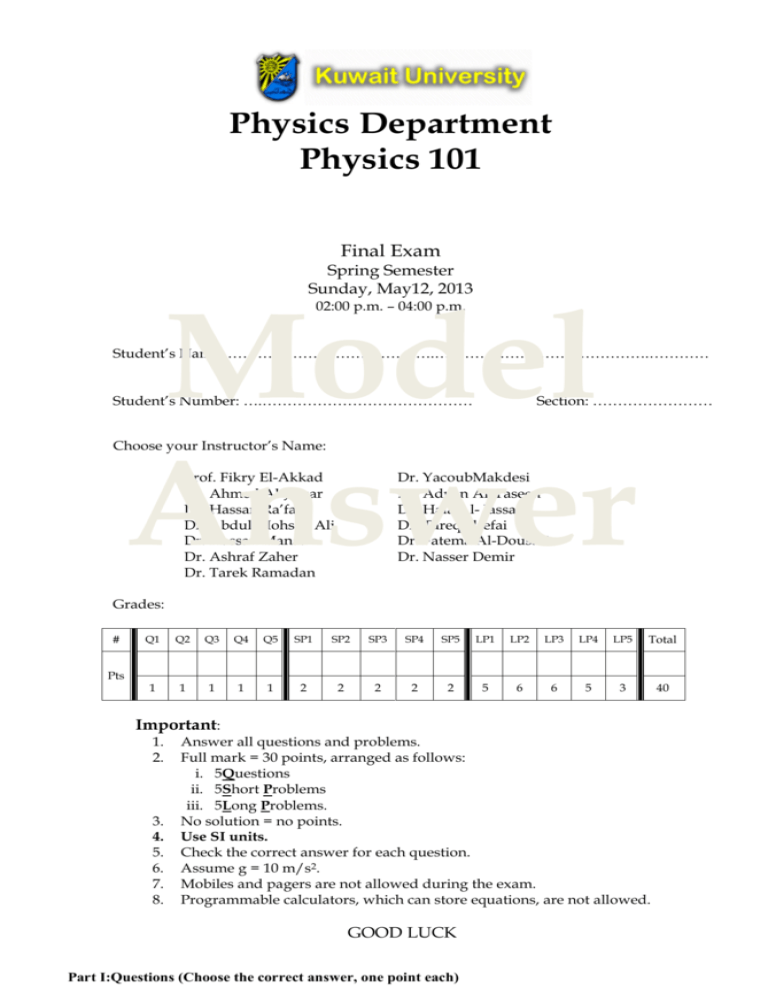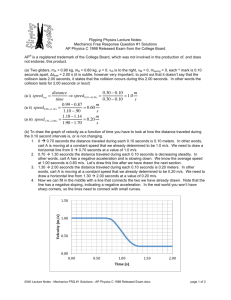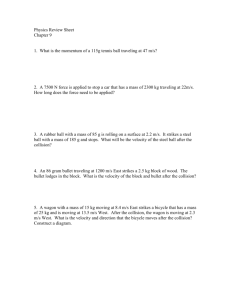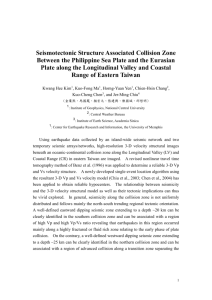Physics Department Physics 101
advertisement

Physics Department Physics 101 Final Exam Spring Semester Sunday, May12, 2013 Model Answer 02:00 p.m. – 04:00 p.m. Student’s Name: ………………..………………….…………………………………….………… Student’s Number: ….…………………………………… Section: …………………… Choose your Instructor’s Name: Prof. Fikry El-Akkad Dr. Ahmed Al-Jassar Dr. Hassan Ra’fat Dr. Abdul-Mohsen Ali Dr. Hassan Manaa Dr. Ashraf Zaher Dr. Tarek Ramadan Dr. YacoubMakdesi Dr. Adnan Al-Yaseen Dr. Hala Al- Jassar Dr. TareqAlrefai Dr. Fatema Al-Dousari Dr. Nasser Demir Grades: # Pts Q1 Q2 Q3 Q4 Q5 SP1 SP2 SP3 SP4 SP5 LP1 LP2 LP3 LP4 LP5 Total 1 1 1 1 1 2 2 2 2 2 5 6 6 5 3 40 Important: 1. 2. 3. 4. 5. 6. 7. 8. Answer all questions and problems. Full mark = 30 points, arranged as follows: i. 5Questions ii. 5Short Problems iii. 5Long Problems. No solution = no points. Use SI units. Check the correct answer for each question. Assume g = 10 m/s2. Mobiles and pagers are not allowed during the exam. Programmable calculators, which can store equations, are not allowed. GOOD LUCK Part I:Questions (Choose the correct answer, one point each) Final Exam – PHYS101 Spring 2012-2013 Q1. A block of mass m is dropped onto a vertical spring of constant k. If the block reaches the spring with a velocity v, then the net work done by all forces during the maximum compression x is: a. – ½ kx2 v b.a. –2 mgx c. – mgx x d. – ½ mv2 e. – ½ mgx Q2. A roller coaster moveson the smooth track as shown in the figure. The radius R A = 2 R B . If the speeds at A & B are adjusted to keep the roller coaster just in contact with the track (N=0), then V A at A is related to V B at B as: a. VA = VB b. VA = 2 VB c. V = V B A 2 d. VA = 2VB e. V = VB A 2 A B RA RB UO Q3. Bader is standing on the floor of a cart that is moving horizontally at a constant speed (Ignore air resistance). He jumps straight up relative to the coordinate system of the moving cart. You may assume that his feet and other body parts move rigidly together. Near which point will he land on the cart floor? a. b. c. d. e. A B C D E is constant as in projectiles B C D V A E Q4. m 1 & m 2 are two equal masses. m 1 moves with speed v toward a stationary mass m 2 . The maximum energy transferred to m 2 occurs if the collision is: a. one dimensional inelastic collision b. perfectly inelastic collision c. two dimensional inelastic collision Inelastic collision (loss of energy) Two dimensional elastic collision (share of energy) d. one dimensional elastic collision e. two dimensional elastic collision with equal angles Q5. A & B are two sprockets connected by a belt that does not slip and runs with constant linear speed v. If r A = 4 r B ,then the relation between their angular velocities ω A &ω B is: v a. ω A = ω B b. ω A = 2ω B v c. ω A = 4ω B d. ω A = ½ ω B e. ω A = ¼ ω B rB rA Part II: Short Problems (2 points each) 2 Final Exam – PHYS101 Spring 2012-2013 SP1. A block of mass 5 kg slides across a rough surface with µ k = 0.6. It collideswith a spring of constant 1000 N/m as shown in the figure A. It compresses the spring by 40 cm (figure B) and then returns back to its original position (figure C). Find the change in kinetic energy (in J) of the block between A and C. A B C J x=0 SP2. A system of three uniform rods of lengths L, 2L and 3L are attached as shown in the figure. If L = 4.0 m,find the coordinates (x cm &y cm ) of the center of mass (in m) relative to the point O. y 3L L O SP3. A particle of mass 8 kg rests on a smooth table. It is acted on by two forces x 2L & . (Note: x and y are in a plane parallel to the surface of the table)The particle moves with constant acceleration of 2.0 m/s2 in the positive x direction. Find is 12.0 N (in the positive y- direction). (in N). (in unit vector notation) y N m N N x m F2x F2y 3 Final Exam – PHYS101 Spring 2012-2013 SP4. m 1 & m 2 are two equal masses. m 2 is stationary and m 1 runs toward it with a speed of 50 m/s. After two dimensional elastic collision it is found that m 2 will move with a speed of 30 m/s at an .Find the velocity (in m/s), in magnitude & direction of m 1 after this elastic collision. v1 = ? (equal masses) m1 m1 m2 v2= 30 m/s 8 kg SP5. The four masses shown in figure are connected by 12 kg r r massless rods and rotates horizontally about the center point O with constant angular velocity of 2 rad/s. r Find the total rotational kinetic energy (in J). 12 m O r 16 m 12 kg 8 kg J Part III: Long Problems (Points for every problem are listed on the cover page) LP1. m 1 is released from rest in the system shown in the figure. The disk P has moment of inertia of 0.36 kg m2 f P and its radius is 0.6 m.If frictional tangential force of the disk is 5N,find the acceleration of m 1 (in m/s2) m1 8.0 kg 4.0 m m2 2.0 kg f T1 T1 T2 T2 disk m1 g m1 m2 g m2 4 Final Exam – PHYS101 Spring 2012-2013 LP2. In the figure shown, the left track is smooth. m 1 (8 kg) is released from rest from a height of 5m. It collides and stick with a stationary mass m 2 (12 kg). Both masses move together by a distance of 2 m on a rough horizontal surfaceuntil they stop. Find: m1 = 8 kg a. The coefficient of kinetic friction of therough surface. b. The loss in kinetic energy(in J) during collision. m2 = 12 kg 5m smooth surface a) b) rough surface J LP3. During construction of a very high tower a hammerhead with mass of 200 kg is dropped from height of 5 m above the top of I-beam being driven into the ground. Accordingly the I-beam is driven 18 cm into the ground. The vertical rail that guides the hammerhead exerts a constant frictional force of 380 N on the hammerhead.Find: a. Velocity (in m/s) of the hammerhead just before it collides with the I-beam. b. The average force (in N) the hammerhead exerts on the I-beam. (neglect air resistance) a) Hammer head guide rail n 5m f I beam mg b) ground = 4.66 ×104 N LP 4. A homogenous rod of mass (m) of0.5 kg and length (l) of 30 cm is pivoted from one end at point O and is kept horizontally (pivot is frictionless). It is then releasedformthe rest.Find: a. The moment of inertia (in kgm2) of the rod about O. (I cm = m l2 ) b. The linear speed (in m/s) of the free end (a) as it passes the O mg l/2 vertical position. = 0.015 kg m2 a) a b) rad/s 5 a Final Exam – PHYS101 Spring 2012-2013 LP5. Felix rises up in a huge balloon from the ground (Level A) with constant speed of 5 m/s. Arriving at height of 39 km (Level B), then he releases himself in space (as free fall) and descends in air by total distance of 36500 m (Level C). (New record) 39000 m LEVEL - B The measured velocity at C is 373 m/s. He then opens the parachute and continues his way to the ground (Level A). Calculate the work done by air resistance during the 36500 m falling distance from Level B to Level C. His total mass including the parachute is 100 kg. 36500 m (260 s) = 2.95×107 ~ 3×107 J 5 m/s LEVEL - C V = 373 m/s LEVEL - A Balloon launches, carrying Felix in the capsule. Return to LEVEL - A 2500 m 280 s On October 14th 2012, An Australian athlete (Felix Baumgartner) has record to be the first man breakup speed of sound. His velocity at level C is 373 m/s (velocity of sound is 340 m/s) This incredible event is summarized in the following problem (with some simplifications) 6








